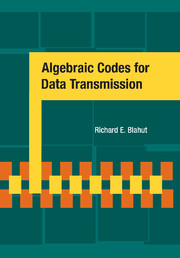Book contents
- Frontmatter
- Contents
- Preface
- Dedication
- 1 Introduction
- 2 Introduction to Algebra
- 3 Linear Block Codes
- 4 The Arithmetic of Galois Fields
- 5 Cyclic Codes
- 6 Codes Based on the Fourier Transform
- 7 Algorithms Based on the Fourier Transform
- 8 Implementation
- 9 Convolutional Codes
- 10 Beyond BCH Codes
- 11 Codes and Algorithms Based on Graphs
- 12 Performance of Error-Control Codes
- 13 Codes and Algorithms for Majority Decoding
- Bibliography
- Index
11 - Codes and Algorithms Based on Graphs
Published online by Cambridge University Press: 05 June 2012
- Frontmatter
- Contents
- Preface
- Dedication
- 1 Introduction
- 2 Introduction to Algebra
- 3 Linear Block Codes
- 4 The Arithmetic of Galois Fields
- 5 Cyclic Codes
- 6 Codes Based on the Fourier Transform
- 7 Algorithms Based on the Fourier Transform
- 8 Implementation
- 9 Convolutional Codes
- 10 Beyond BCH Codes
- 11 Codes and Algorithms Based on Graphs
- 12 Performance of Error-Control Codes
- 13 Codes and Algorithms for Majority Decoding
- Bibliography
- Index
Summary
The theory of algebraic codes draws much of its strength from the structure and properties of finite fields. In earlier chapters these properties were used to develop powerful codes and efficient decoding algorithms. The properties of those codes are tightly coupled to the properties of the fields, and the decoding algorithms use the full structure of the field to realize computational efficiency. Algebraic codes are attractive, not necessarily because of their performance, but because their structure is closely entwined with the rich structure of finite fields, a structure that underlies practical encoder and decoder implementations.
However, not every code is well-suited to the powerful algebraic decoding algorithms that are now known and not every physical channel is well-described by the mathematical structure of a finite field. Moreover, a physical channel is usually a waveform channel that transmits real or complex functions of continuous time. The methods of modulation and demodulation allow the continuous channel to be treated as a discrete channel, transmitting real or complex sequences indexed by discrete time. The sequence of codeword symbols from a finite field must be mapped into the real or complex field to form a sequence of real or complex inputs to the channel. The sequence of real or complex outputs from the channel may be mapped back to the finite field but the map takes many values to one and information is lost.
- Type
- Chapter
- Information
- Algebraic Codes for Data Transmission , pp. 335 - 374Publisher: Cambridge University PressPrint publication year: 2003



